I stepped outside and the smell of humid concrete and sweating leaves signalled to my senses it was summer. The warm Northerly whipped through Wellington with the youthfulness of good news. On my bike commute the Northerly is my tailwind home, speeding me quick to my house, to my pre-packed car full of ice axes and crampons to seek an adventure colder from here.
My Canadian friends (Jenna and Jordan), SK and I were headed down to the northern end of the South Island to Nelson Lakes National Park. On the objective list was Mount Hopeless: with a name so tantalizingly romantic how could I resist? This trip was a bit different from other ventures in that we would have to get to the South Island (day 1) hike to the hut (day 2) which would then act as our base for attempting the summit (day 3) and then walk out again (day 4). So in addition to our climbing gear (harnesses, carabiners, 60 meter rope, helmet, ice axes, snow anchor, avalanche probe, shovel, etc) we would also need sleeping gear and cooking utilities. Hearing such a list, you might be unsurprised to hear my backpack was somewhere between 25-30kgs (55-66lbs). Jesus H. Christ is right.
We left after work and took the Interislander ferry to Picton, arriving somewhere around midnight, and drove two hours to Nelson Lakes. With the new moon lighting nothing, our car’s headlights signaled our arrival to the campsite’s rabbits who parted like water as they darted from the front of our car. Since they are an invasive species in NZ, we tried to hit as many as we could (kidding – but it wouldn’t have been a shame had we). We set up our tents and passed out.
The next morning I woke up in Vermont. Tall trees surrounded our campsite and the sounds of birds echoed louder than my alarm. Out of the tent I saw a dock leading to a gorgeous lake, its mountains softened by mist to look as if they were the glacier molded hills of home. I walked down the dock and peered into the still water, as clear as any part of the Deerfield, and was shocked back to New Zealand as an eel six feet long and six inches in diameter peeked up at me from its clear depths. The eel, ever so delicately, touched its nose to the lake’s surface: as if a hopeful pup in search of a wandering hand – but my hands don’t tend to wander around eels.
We broke camp, took a boat to the other side of the lake and started our hike to the hut with our dense backpacks. It was quite comical to see our line of intrepid selves amidst a blazing summer with winter gear hopefully attached to our backs. En route to the hut we ran into “the Character”. The Character smiled at us with cigarette stained teeth and eyed our weighty packs: “Where are you going?”
Us: “Attempting Mount Hopeless tomorrow.”
Character: “Snap! What route?”
Us: “Hopeless Creek Route.”
Character: “Snap! I tried it a week ago, but there was too much wind. You will need crampons. You have crampons? Oh and you have technical ice axes? And rope? You won’t need those. Your packs must be heavy. Well, I’ll see you at the hut.”
The Character trounced off with his much lighter pack. After the Character’s final judgement of our equipment, I wondered if “snap” meant the same thing in NZ as it did in USA (‘snap’ [adj.]: awesome, a term used when the speaker is impressed) because the Character certainly seemed anything but. A few minutes later I asked SK: “What does ‘snap’ mean in NZ?”
SK: “It means ‘me too.’” So no, the Character was not impressed, he was being just as disparaging as he came off. And, bonus, we would be sharing our hut and hiking plans with him. Joy.
The remainder of the hike was laborious, mostly due to the weight of our packs, and it took effort to remind myself to lift my head and look around. The path took us slowly higher and higher on a winding track whose only direction was to follow a river. We snaked our way through trees and grass and gained height only at the reverse of a waterfall. Exposed rock worn free by hundreds of years of pounding stream ran smoothly under our feet, offering a not-so-tempting slide to the smooth crevassed rapids below. Having gained our height we left the rock’s dramatic antics behind and found ourselves on a path of emerald moss with chandeliers of sage dangling delicately over our heads. We crossed smaller stream beds, both dry and full, pausing to stop to fill our bottles in the later and not having to wait to steralise before parching our march’s thirst. A benefit to NZ’s lack of mammals: the water in the moutains is pure to drink straight from its source.
After four hours of walking my pack only grew heavier. The weight of it both propelling me forward on downward slopes and dragging me back as I attempted an incline. Time slowed. I dragged. And the estimated time of arrival came and went with only the sighting of another river crossing: one that I did not mind I couldn’t manage dry.
Finally, from up ahead, the triupmant cry of Jordan spurned on my weighted waddle to at last see the beautiful crest of our humble DOC abode.
We got to the hut and the Character was waiting, his legs crossed at the kitchen’s table and a self-rolled cigarette dangling determinedly from his mouth, “Welcome,” he said but his eyes waited for us to comment on the smoke leaking from his mouth inside the communal space. Unfortunately for his preemptive self-victimization, Kiwis and Canadians are too polite to comment (and I, the sole American, was too much in the minority!). Instead we set about vigorously rubbing our feet and unpacking our bags. While we organized our things the Character chipped in with a litany of judgemental commentary: “La Sportiva boots? Those must have been expensive. How much did you pay for them? You see mine? I got them for free. Otherwise I would never have been able to afford them! But they serve me well. You’re bringing up a rope? What is that, 60 meters? That must be heavy. You don’t need that rope. Is that a personal locator beacon? Wow, mine is about two times the size of that! Don’t bother with one now: I just take the risk. And I wouldn’t bother with those avalanche transceivers. You won’t need two ice axes, especially not two technical ones. I do everything with my walking ice axe and I’m fine.”
After about 15 minutes of his “Climbier-than-thou” dialogue, I had enough: “Yeah, well we’re just beginners so we’re going to bring what makes us comfortable.”
The Character humphed to himself: “Do what you want, I’m just trying to save you a lot of weight. What time are you leaving tomorrow?”
“5/5:30AM”
“Jeeze! You don’t need to leave that early! I’m planning on heading out at 10! You might as well sleep in!” I walked out. The others followed.
The route to the summit of Hopeless is unmarked so we decided it would be good to climb up to the edge of the bushline to make sure we knew where we were going in the darkness of our pre-dawn start. Sans packs we easily rock hopped our way over a river and called out to each other as we found ten paces of a trail before it split into two ambiguous directions. One of us would scout one way while the other took the second and we’d mentally map which way was simpler. This continued for about 200 meters vertical. Roots served as handholds as we pulled our way through whipping bush wondering what this would possibly be like with a full pack on our backs. But we had excitement on our side. For as much as the Character was a dark abyss of self-doubt inspiring negativity: this was our first mountaineering trip to the South Island and we were on the enchanting slopes of Mount Hopeless! A mountain so called for it was considered impossible to climb until 1933. By the by, the first known ascent of Mount Cook was 1894. Although, to be fair, some random peak in NZ might not have been high on the h-core mountaineer’s objective list in the first place, my pride doesn’t mind the inferred conclusion these facts might lead you to.
Months earlier an instructor had mentioned her name, Mount Hopeless, as a good objective to have for a mountain to climb post course. Interest piqued by her defiant title, I researched the climb and fell in love with her elusivity. Her summit is perfectly postured, the summation of three ridges twisting, twirling towards the sky, like a dancer paused in motion, her three arms poised in coy devotion. A hard invitation; a challenging beckoning to see who I was; an inverted amphitheater on which to seek my limits and test them, as Hopeless watched from her snow encased throne. With the hard-won success of Girdlestone riding on my mind, self-doubt didn’t play a part in setting my sights on what I would later learn was the most technical peak in the region.
Back at the hut, sleep did not come easily and was made worse by the good intentions of an early night. My mind raced with trepidation of how my fear of heights would cope and whether I could mentally handle the exposure of Hopless’ height. My thoughts cruelly drifted to SK and the ‘what-if’s’ of a misplaced step. I shuddered in my sleeping bag, willing to shake the thoughts away that I might have some well needed sleep. I began to count my breath, deep long intakes to sooth my mind to rest.
5:00AM. The alarm sounded. In silence we ate a quick breakfast of granola bars, brushed our teeth, turned on our headlamps and started the trail. My blood pumped coffeelessly in the earth’s sunless cold. My slumbered senses jarred with the harsh start of steep rock as I forced my body through lithe trees up the foothill of Mount Hopeless. We broke the bush line just as the sun broke past the horizon’s barrier and broke our morning silence. The sun’s kiss noticeably warmed our cheeks as well as those on the faces of nearby mountains. With continued on, the grass offering less obstacles although making up for it in gradient. We came to snow and put on our crampons and switch backed our way until we reached a bowl at the base of where the climbing gets steeper. We checked the topo map and noted two possible routes: the left was the actual route (we did not figure this out until later), up a steep couloir which would bring us to a saddle at the base of the summit plateau. To the right was a less steep slope up to the ridge which then joined the saddle after about 120 meters of ridge travel. We went right.
The Canadians started ahead while SK and I closely followed. As we reached the ridge my confidence began to waver as I realized the far side of the ridge offered a far worse fall. While on the side we were approaching from the exposure (height) was only about 200 meters, the far side offered a very quick trip to the bottom 800 meters down (FYI that is 200 meters short of a KILOMETER DROP). While it wasn’t necessarily over a cliff, it was certainly a long, long, long way to go.
“Rationally speaking, I have the skills to prevent myself from falling over this,” my inner dialogue attempted to take control of the situation. “I know how to self-arrest, I know how to walk on snow and, in fact, this ridge would be no big deal if it were only a foot drop to either side, so why should it be any different with the increased drop?” By the way, this rationality doesn’t effing work. Instead, I begin to use all four of my limbs in an attempt to give myself greater confidence: “Two crampon-ed feet and two ice axes, I am a four limbed animal, I have great, great balance. I am fine. I am sturdy.” These thoughts chaotically tossed themselves around my head and I desperately tried to find one which would provide a solid mental ground to stand on. Ahead, the ridge narrowed to barely a foot’s width. On one side a cornice (an overhanging piece of ice that if made unbalanced by an external factor (ie me) would crack and break off down the slope) and another narrow bit of mixed snow and ice clinging to a rock. I gritted my teeth and narrowed my mind to one mantra, “I am balanced. I am okay. I am balanced. I am okay.” Moving one ice axe then the other I transferred my weight from the cornice to the rock and sidled myself back onto the secure ridge that returned on the other side. I breathed a sigh of relief, proud and terrified of my accomplishment.
I turned to face forward along the ridge and saw Jordan just beyond a final step on what looked like the summit: “Come on, Jade,” I whispered aloud to myself, “You can do it. It is just there. Come on.” I reached the final step and begin to feel a rise of panic as, again, the gravity of exposure tugged hard at my confidence. I placed my ice axes high, over the step and lifted my leg to shift my body weight up. I froze. I turned my head to look at my leg and saw that I, in my fear, had put my knee on the slope as a way to leverage myself up. This is a very, very grave mistake. And I was suddenly acutely aware that I was beyond the point of fear that is safe, for I had passed the point of logic. Rationally speaking, there is no way that my knee against the slope would have had more grip than my crampon. However, in the irrational haze of my fear, my posture changed and, in-so-doing, put balance and my body in far greater danger. I slowly took my knee off the slope and replaced it with my crampon and stepped up. I rested for a second there, holding my place above the step as I let the significance of my mistake wash over me and hit home – not in an angry way but in a very pointed way. I rose and walked slowly, thoughtfully to what I then discovered was only the false summit.
SK is already there and I can see, for the first time ever in all of our expierence of the mountains, fear in his eyes. “How are you doing?” I ask.
“Honestly,” SK remarked, “I am shitting myself.”
I looked beyond him at the summit and saw Jenna and Jordan continuing ahead. “What do you think?”
SK followed my eyes, “I feel accomplished with having got here. I don’t really feel a need to go for summit.”
A part of me washed over in gratitude. Another part looked logically, stubbornly at the technical aspect of pushing forward: “We do have the skills to do it. We have the rope. The main thing is whether we have the time and energy to add it to our descent.”
SK looked at the summit: “If we went forward, I would want to get the rope out. That would slow us down and we are already going pretty slow. My guess is it would take us two hours to get from here to the summit and return back to where we are now.” We fell silent as we each individually assessed our energy levels.
I thought about how close I came to climbing on my knees. Mentally, I am crushed and I am aware my exhaustion could affect my foot placement. I knew that while I had the technical ability to get to the summit my fear had utterly exhausted me: I just couldn’t say it yet. “What do you want to do?” I asked SK.
“Energywise, I don’t think I would be as safe on the way down if we continued. My vote is to go back. I’m good with here.”
I nodded with honest agreement, “Yes, ‘here’ is quite the damn accomplishment.” We share a nervous laugh and get out the rope for our descent.
Further along, Jenna and Jordan (who are slightly more experienced with exposure!) meet up with the Character as the saddle just below the summit plateau. After an awkward interaction in which the Character presumptuously stated: “I’m not going up to the summit unless I’m on your rope!” Jenna and Jordan decide to turn around. Uncomfortable with the idea of tying into the rope with someone they had never climbed with before (which is entirely rational as adding a third person does mean you are putting your life in that person’s hands) they decided not to go for summit. Truly, it was really bad mountain form of the Character to even ask to go on their rope.
We returned down and ate our lunch. Despite not reaching the summit, spirits remained high as we all rated the trip a success. Not far from the summit, we had made it a huge way for our skill level and had done alright with our first true exprience with exposure. We did not lose any equipment and, most importantly, we were all safe and uninjured. I was proud that we were able to continue to make decisions that were right for us. And I was exceptionally proud and grateful to have a climbing partner like SK who was able to think clearly through the haze of fear to signal the time to turnaround.
We continued down, talking about the ridge line and wondering whether the route to the left would have been less mentally draining with the lack of exposure. We admired the horizon and its multitude of snow covered mountains piercing the land and air with pure white pricks of snow. We returned to the hut and the Character blissfully let us be and we all fell into a much deserved sleep.
The next morning, Jordan and I woke early before sunrise to climb the ridge opposite Hopeless in hopes of seeing our route and her summit peak. Finally gaining height, we sat enchanted as the dawn clouds silently evaporated in the sun who painted rose Mount Hopeless’ slopes. Still, from our vantage, we could not see her vertex. Ever elusive, Mount Hopeless’ summit remained privy only to those worthy of reaching it.
Being back. Being back has felt a bit – each time I come back I find what I do on a daily basis more and more suffocating. I find solace in my bike rides. I find long runs through Mount Victoria soothing. But my lunch at work tastes stale in my mouth. My crossing of roads is full of artificial intention I create with invented purposefulness. Each task is short enough to keep my sanity from seeing too far into the future to desolate unfulfillment. The months until June (Southern Hemisphere winter) stretch before me and I break things down. I conspire stress to pass the time quicker. My heart beats for the weekend and my sick days are my rest days. I do not have time to stop. Because if I do. Well. What if my dissatisfaction catches up?
Still, I find this mountaineering to be a labyrinth of mirrors and I am at a loss at what I will find at the center. If I get to the center. Too many mirrors reflected could twist me off a cliff. Each curve dips deeper into layers I had not considered before – as if I am accessing dimensions of myself previously overlooked in the routine of brain function.
On Saturday I attempted Mount Hopeless. On Sunday I was sore physically. On Monday I was sore mentally. Back at the rock climbing gym, I found I could only climb grades way lower than normal. A wise friend said to me “You have let alpine get into your head. You can fall on rock. You’re not allowed to fall on the mountain. But here, just let go.” Maybe I had. Maybe the terror of standing on the ridge was more than I had imagined. Maybe the fear had seeped its way into my very bones and was only just starting to secrete itself out of my marrow, into my veins – until it eventually pumped itself dry.
Today, I did not climb again. I could feel the fear there and I did not want to have to try and tackle it again. I couldn’t face it. I couldn’t face the frustration at the invisible nothing that was haunting my head and jolting my muscles at the moment of uncoiling – tensing them to freeze. The invisible hand of it flaring my self-doubt at the last moment of every step. Which brings to question, can I envision my success? Can I instead, in the moment of doubt, flash a brilliant moment of self-belief? I would be so powerful. I would be unstoppable. But how is that something to cultivate? How does one cultivate belief in one’s self at the expense of doubt? Have I been raised in a culture of doubt? Or is my self-doubt a product of me? Where is the root of this twisted weed – for it’s impossible I was born with it. How does one evict self-doubt?
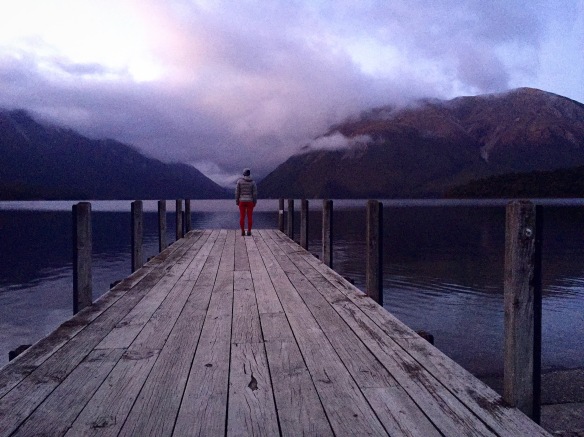
At the dock before sunrise, getting ready for our boat to take us to the mountain’s beyond the hill’s shoulders.
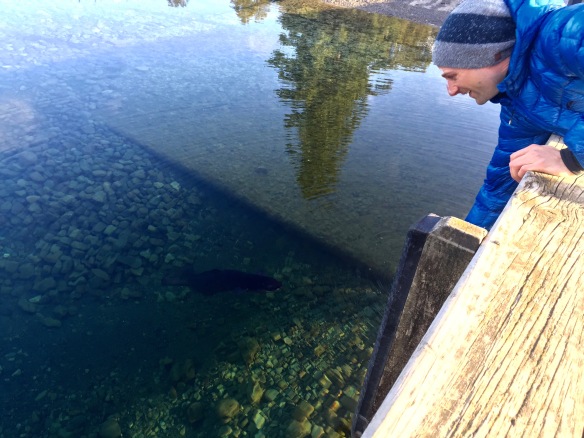
Jordan is a bit more eager to entertain the eels with his fingers than I am!
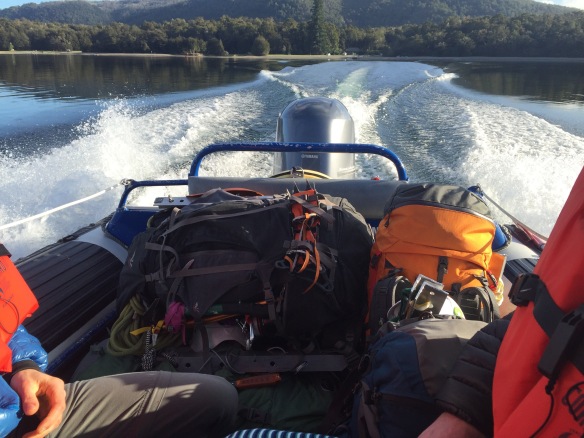
Our packs tossed in the back of the boat that will take us to the start of the track.
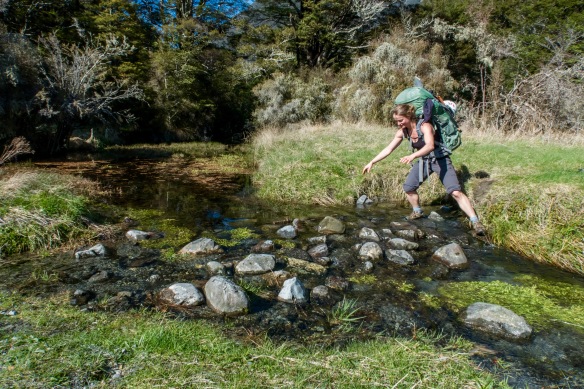
River crossing back at the beginning when I had the energy to care about staying dry. Little did I know, this was one of the easier crossings! (Photo credit: Stoked for Saturday)
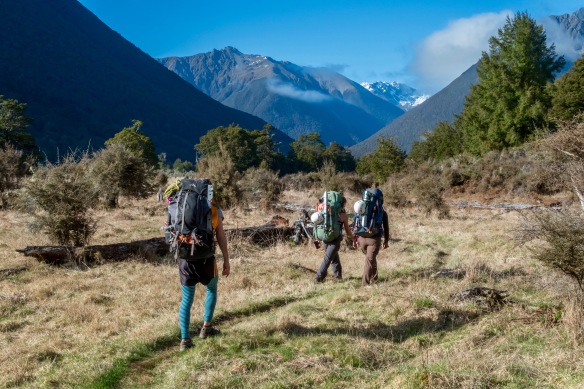
Walking up the valley, I’m with the green bag, Jenna to my right and SK taking up the rear with his flamboyant knickers, I mean, long johns. (Photo credit: Stoked for Saturday).
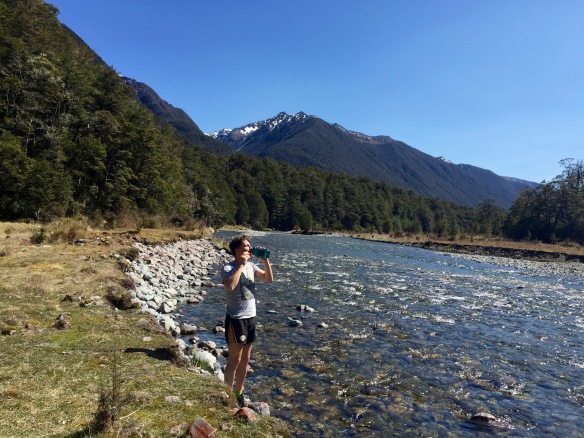
Drinking water straight from the river. #nofilter
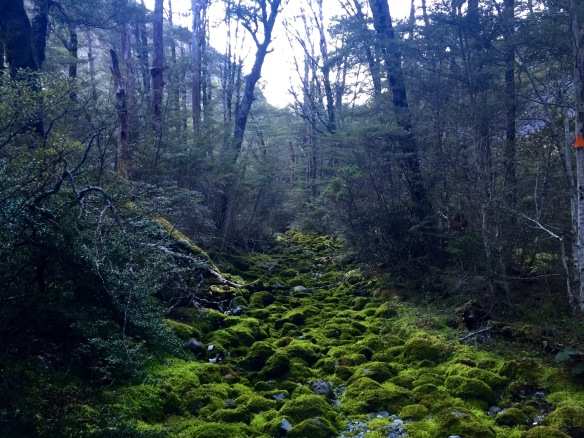
Emerald carpet leads the way to our hut.
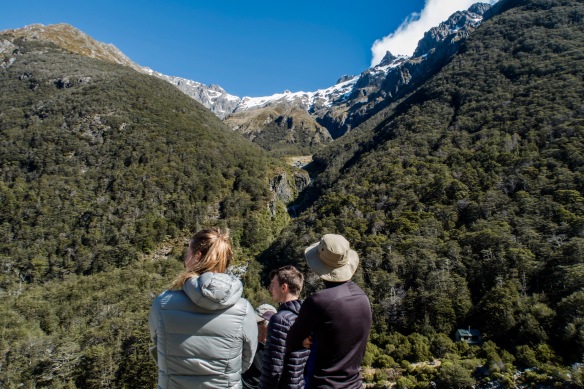
Figuring out where the trial might go to get up to Mount Hopeless. We later learn it is up to the right of the ravine, up the bush-grass slope to the snow and then veers right towards the sharp pointy bit to the right. (Also: see our wee hut to the right, might help give a sense of scale!). Photo credit: Stoked for Saturday
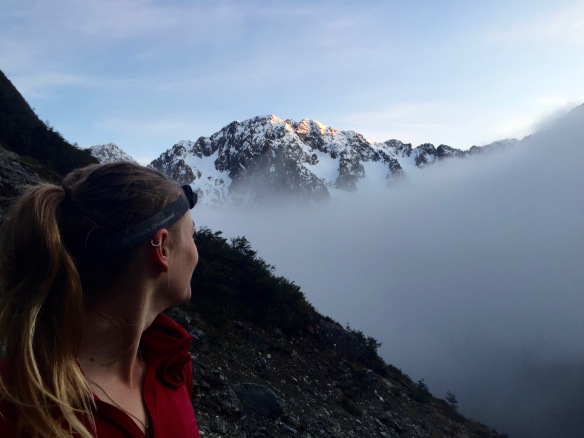
The sun joined us around 6:00am on our ascent. Photo credit: SK.
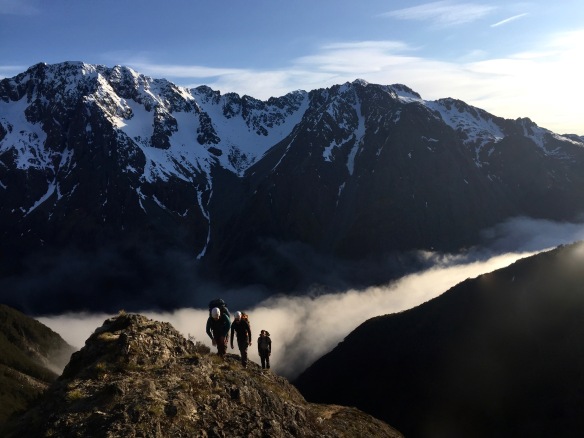
Mount Hopeless sunrise.
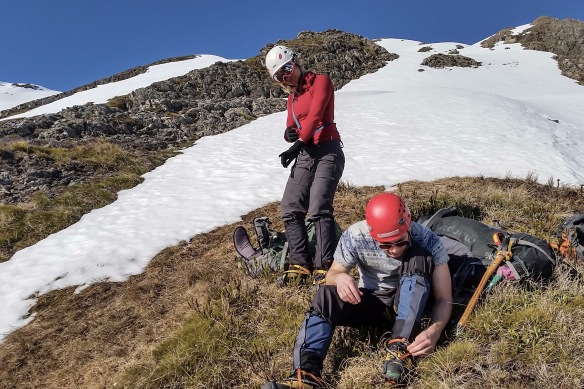
Getting our crampons on as we switch to a snow ascent. Photo credit: Stoked for Saturday

Heading into the bowl – this is where things start to get a bit more technical. To the middle of the photo (at about 1:00 from the guy up front) is the actual route. To the left and off this photo and above the bluffs to the right top of this photo is the route we invented and took instead. Photo credit: Stoked for Saturday.
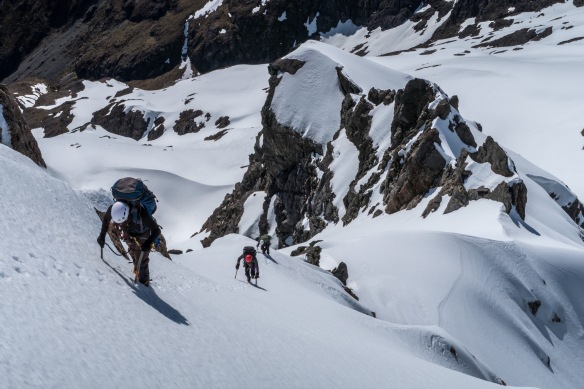
Heading up the ridge of Mount Hopeless. Jenna up front followed by SK and me in the back. To give you a point of reference, the sharp bit of rock behind me is the “sharp pointy bit” I described in an earlier caption. Photo credit: Stoked for Saturday.
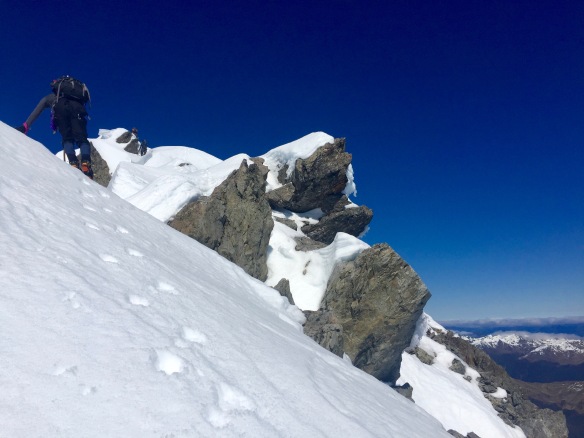
SK balancing his way along the ridge, the false summit peaking up deceptively in the background.
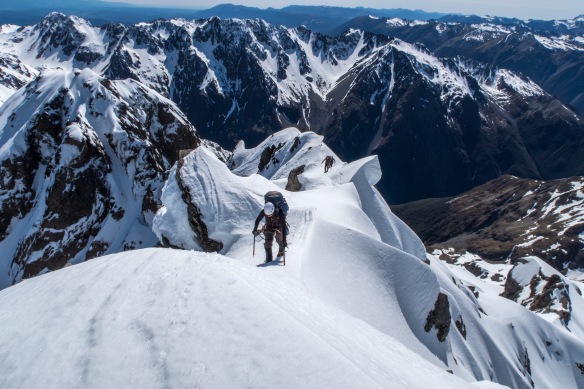
The terrible and beautiful ridge of Mount Hopeless. Photo credit: Stoked for Saturday
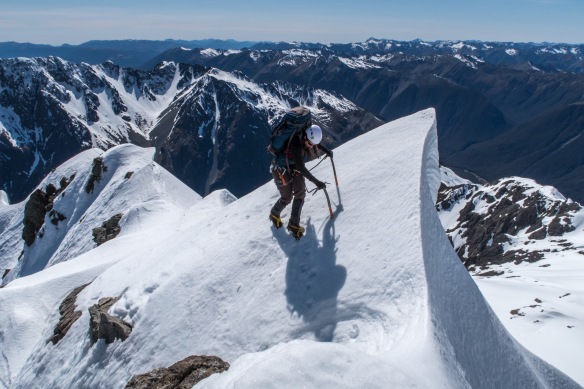
Jenna maneuvering the tricky section with a cornice to her left (right of the photo) and a sharp fall to her right (left of the photo).
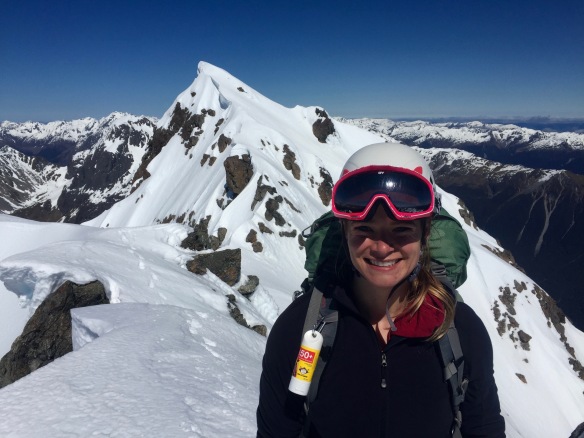
Me as close to Hopeless as I am going to get. This trip. Note the awkward smile that is me attempting to still be excited about this moment while still unfortunately in this moment.
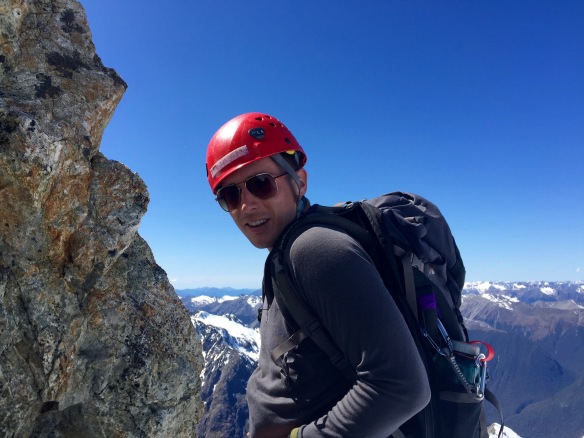
My very handsome climbing partner, SK, used the rock in front of him as a belay station to bring me back down to almost safety.
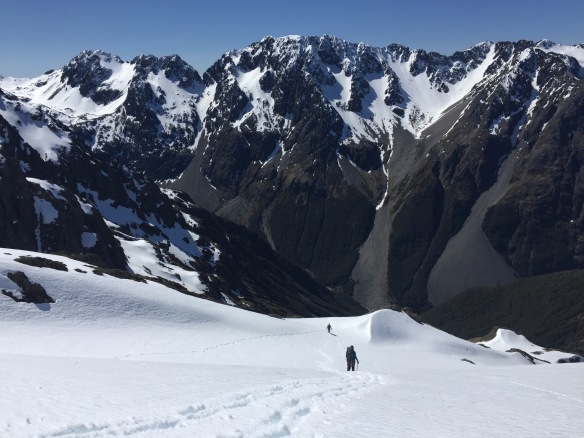
Finally back on stable ground, we “ski” our way back to the hut in the soft snow of a gorgeous afternoon.
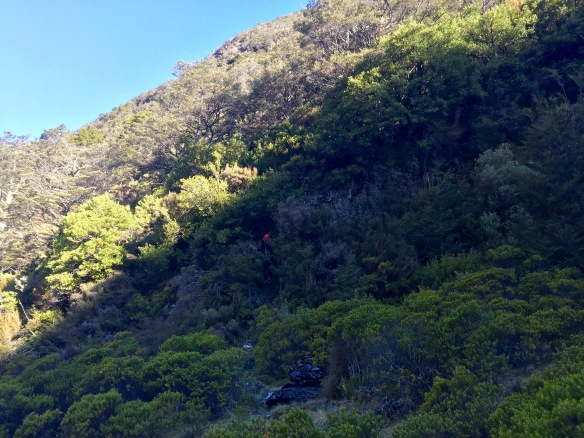
This is the only photo I captured of our scramble ascent up the bushes. The red dot is SK’s helmet as he works to slide down a short, sheer piece of rock while holding onto flimsy branches to either side.
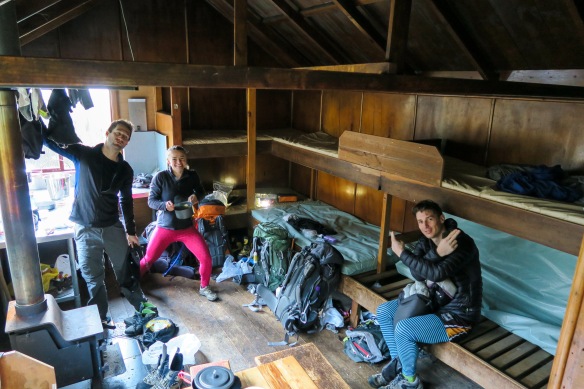
Breakfast time inside the hut – perhaps a tad delirious after our the big summit push the day before.
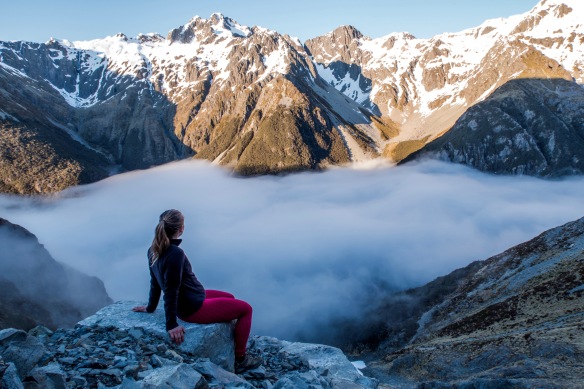
Mount Hopeless dominates the horizon with two of her ridges riding high to hide her true summit. I am beyond grateful to have spent the days adventuring with her and learning from her. Although sad to leave, I already begun to conspire my second visit and summit attempt. It would seem, after everything, I am hopelessly in love with Mount Hopeless. Photo credit: Stoked for Saturday.











































































































